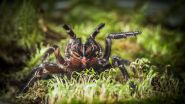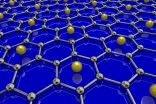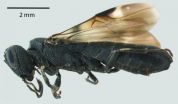(Press-News.org) Got rope? Then try this experiment: Cross both ends, left over right, then bring the left end under and out, as if tying a pair of shoelaces. If you repeat this sequence, you get what's called a "granny" knot. If, instead, you cross both ends again, this time right over left, you've created a sturdier "reef" knot.
The configuration, or "topology," of a knot determines its stiffness. For example, a granny knot is much easier to undo, as its configuration of twists creates weaker forces within the knot, compared with a reef knot. For centuries, sailors have observed such distinctions, choosing certain knots over others to secure vessels -- largely by intuition and tradition.
Now researchers at MIT and Pierre et Marie Curie University in Paris have analyzed the mechanical forces underpinning simple knots, and come up with a theory that describes how a knot's topology determines its mechanical forces.
The researchers carried out experiments to test how much force is required to tighten knots with an increasing number of twists. They then compared their observations with their theoretical predictions, and found that the theory accurately predicted the force needed to close a knot, given its topology and the diameter and stiffness of the underlying strand.
"This is the first time, to the best of our knowledge, that precision model experiments and theory have been tied together to untangle the influence of topology on the mechanics of knots," the researchers write in a paper appearing in the journal Physical Review Letters.
Pedro Reis, the Gilbert W. Winslow Career Development Associate Professor in Civil Engineering and Mechanical Engineering, says the new knot theory may provide guidelines for choosing certain knot configurations for a given load-bearing application, such as braided steel cables, or surgical stitching patterns.
"Surgeons, of course, have a great deal of experience, and they know this knot is better for this stitching procedure than this knot," Reis says. "But can we further inform the process? While maybe these knots are used, we might show that some other knots, done in a certain way, may be preferable."
A twisted theory
Reis' colleague, French theoretician Basile Audoly, originally took on the problem of relating a knot's topology and mechanical forces. In previous work, Audoly, with his own colleague Sébastien Neukirch, had developed a theory based on observations of tightening a very simple, overhand knot, comprising only one twist. They then verified the theory with a slightly more complex knot with two twists. The theory, they concluded, should predict the forces required to tighten even more complex knots.
However, when Reis, together with his students Khalid Jawed and Peter Dieleman, performed similar experiments with knots of more than two twists, they found that the previous theory failed to predict the force needed to close the knots. Reis and Audoly teamed up to develop a more accurate theory for describing the topology and mechanics of a wider range of knots.
The researchers created knots from nitonol, a hyper-elastic wire that, even when bent at dramatic angles, will return to its original shape. Nitonol's elasticity and stiffness are well known.
To generate various topologies, the researchers tied knots with multiple overhand twists, creating increasingly longer braids. They then clamped one end of each braid to a table, used a mechanical arm to simultaneously pull the knot tight, and measured the force applied. From these experiments, they observed that a knot with 10 twists requires about 1,000 times more force to close than a knot with just one.
"When Pedro Reis showed me his experiments on knots with as much as 10 twists, and told me that they could resist such a high force, this first appeared to me to be far beyond what simple equations can capture," Audoly says. "Then, I thought it was a nice challenge."
From shoelaces to surgery
To come up with a theory to predict the forces observed, Reis and Audoly went through multiple iterations between the experiments and theory to identify the ingredients that mattered the most and simplify the model. Eventually, they divided the problem in two parts, first characterizing the knot's loop, then its braid. For the first part, the researchers quantified the aspect ratio, or shape of a loop, given the number of twists in a braid: The more twists in a braid, the more elliptical the loop.
The team then studied the forces within the braid. As a braid, or twist, is symmetric, the researchers simplified the problem by only considering one strand of the braid.
"Then we write an energy for the system that includes bending, tension, and friction for that one helical strand, and we are able to determine the shape," Audoly says. "Once we have the shape, we can match it to this loop, and ultimately we get the overall force displacement response of the system."
To test the theory, Reis plugged the experiments' measurements into the theory to generate predictions of force.
"When we put the data through the machinery of the theory, the predictions and the dataset all collapse onto this master curve," Reis says. "Once we have this master curve, you can give me a bending stiffness and diameter of a strand, and the number of turns in the knot, and I can tell you what force is required to close it. Also, we now understand how the knot locks itself up when more turns are added."
Reis envisions multiple applications for the group's theory, both significant and mundane.
"This theory helps us predict the mechanical response of knots of different topologies," Reis says. "We're describing the force it requires to close a loop, which is an indicator of the stiffness of the knot. This might help us to understand something as simple as how your headphones get tangled, and how to better tie your shoes, to how the configuration of knots can help in surgical procedures."
INFORMATION:
This research was funded in part by the National Science Foundation.
Additional background
ARCHIVE:
Wrinkle predictions
ARCHIVE:
Untangling how cables coil
ARCHIVE:
Morphable surfaces could cut air resistance
WORCESTER, MA -- Researchers at the University of Massachusetts Medical School are the first to show that it's possible to reverse the behavior of an animal by flipping a switch in neuronal communication. The research, published in PLOS Biology, provides a new approach for studying the neural circuits that govern behavior and has important implications for how scientists think about neural connectomes.
New technologies have fueled the quest to map all the neural connections in the brain to understand how these networks processes information and control behavior. The human ...
SALT LAKE CITY, Sept. 7, 2015 - If you are in a special relationship with another person, thank grandma - not just yours, but all grandmothers since humans evolved.
University of Utah anthropologist Kristen Hawkes is known for the "grandmother hypothesis," which credits prehistoric grandmothering for our long human lifespan. Now, Hawkes has used computer simulations to link grandmothering and longevity to a surplus of older fertile men and, in turn, to the male tendency to guard a female mate from the competition and form a "pair bond" with her instead of mating with ...
Physicists from the Department of Nanophotonics and Metamaterials at ITMO University have experimentally demonstrated the feasibility of designing an optical analog of a transistor based on a single silicon nanoparticle. Because transistors are some of the most fundamental components of computing circuits, the results of the study have crucial importance for the development of optical computers, where transistors must be very small and ultrafast at the same time. The study was published in the scientific journal Nano Letters.
The performance of modern computers, which ...
Developing transparent or semitransparent solar cells with high efficiency and low cost to replace the existing opaque and expensive silicon-based solar panels has become increasingly important due to the increasing demands of the building integrated photovoltaics (BIPVs) systems. The Department of Applied Physics of The Hong Kong Polytechnic University (PolyU) has successfully developed efficient and low-cost semitransparent perovskite solar cells with graphene electrodes. The power conversion efficiencies (PCEs) of this novel invention are around 12% when they are illuminated ...
Calculation with electron spins in a quantum computer assumes that the spin states last for a sufficient period of time. Physicists at the University of Basel and the Swiss Nanoscience Institute have now demonstrated that electron exchange in quantum dots fundamentally limits the stability of this information. Control of this exchange process paves the way for further progress in the coherence of the fragile quantum states. The report from the Basel-based researchers appears in the scientific journal Physical Review Letters.
The basic idea of a quantum computer is to ...
DENVER, Colo. -- The International Association for the Study of Lung Cancer (IASLC) today issued a new statement on Tobacco Control and Smoking Cessation at the 16th World Conference on Lung Cancer (WCLC) in Denver. The statement calls for higher taxes on tobacco products, comprehensive advertising and promotion bans of all tobacco products and product regulation including pack warnings.
"Tax policies that increased the cost of cigarettes have played a prominent role in the reduction of cigarette smoking," said Dr. Kenneth Michael Cummings, Professor, Hollings Cancer ...
Scientists studying funnel-web spiders at Booderee National Park near Jervis Bay on the New South Wales south coast have found a large example of an unexpected funnel-web species.
The scientists believe the 50-millimetre spider is a species of the tree-dwelling genus Hadronyche, not the ground-dwelling genus Atrax, which includes the Sydney funnel-web, the only species reported in the Park's records.
"It's remarkable that we have found this other species in Booderee National Park," said Dr Thomas Wallenius, from The Australian National University (ANU).
"It shows ...
Graphene, the ultra-thin, ultra-strong material made from a single layer of carbon atoms, just got a little more extreme. University of British Columbia (UBC) physicists have been able to create the first ever superconducting graphene sample by coating it with lithium atoms.
Although superconductivity has already been observed in intercalated bulk graphite--three-dimensional crystals layered with alkali metal atoms, based on the graphite used in pencils--inducing superconductivity in single-layer graphene has until now eluded scientists.
"This first experimental realization ...
Social network Flickr and citizen science website BugGuide have helped scientists to expand the known range of a rarely collected parasitic woodwasp, native to the eastern United States. Partially thanks to the two online photograph platforms, now the species' distribution now stretches hundreds of miles west of previous records. Previously known from only 50 specimens mainly from the Northeast, now the species was discovered in the Ozark Mountains by researchers from the University of Arkansas. Their study is published it in the open access journal Biodiversity Data Journal.
Spurred ...
[Basel, Switzerland - 8 September 2015] The Drugs for Neglected Diseases initiative (DNDi) has announced today at the 9th European Congress on Tropical Medicine and International Health (ECTMIH) in Basel, Switzerland, the successful completion of Phase I human clinical trials for SCYX-7158 (AN5568), the first oral drug candidate specifically developed from the earliest drug discovery stage to combat human African trypanosomiasis, or sleeping sickness, a deadly parasitic disease transmitted by the tsetse fly.
The Phase I study, conducted in France, assessed the safety, ...





